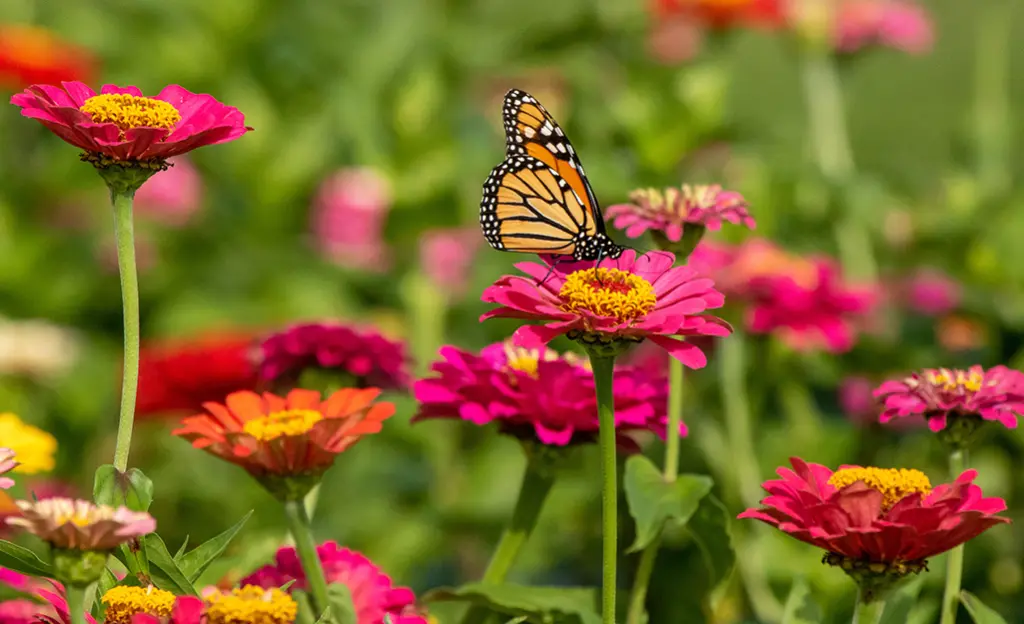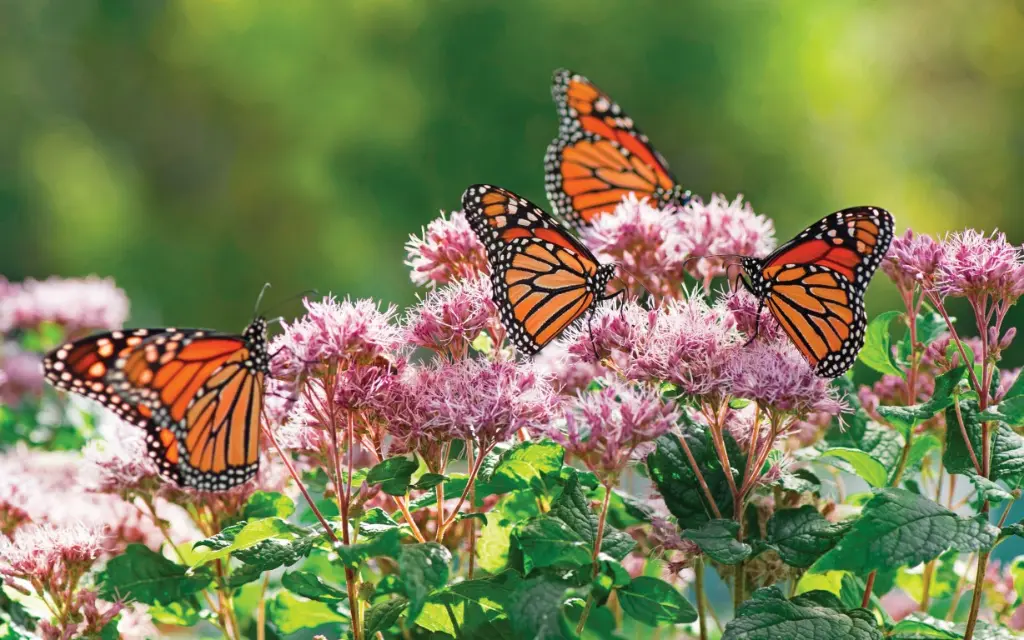
Butterfly gardening involves intentionally designing and planting a garden to attract butterflies. Here’s how you can create your own butterfly-friendly oasis:
What Is Butterfly Gardening?
- Butterfly gardening focuses on providing food, shelter, and breeding grounds for butterflies.
- By selecting the right plants, you can encourage butterflies to visit and even lay eggs in your garden.
Plant Butterfly-Friendly Flowers
Perennials
- Choose perennial flowers that bloom year after year. Examples include:
- Aster (Symphotrichum): A North American native that serves as a host plant for painted crescent and pearl crescent butterflies.
- Bee Balm (Monarda): Attracts a wide range of pollinators, including butterflies.
- Black-Eyed Susan (Rudbeckia): Common wildflower loved by various butterfly species.
Flowering Shrubs
- Include flowering shrubs like:
- Butterfly Bush (Buddleja): A magnet for butterflies with abundant nectar.
- Lantana (Lantana camara): Colorful clusters attract butterflies, bees, and hummingbirds.
Nectar-Rich Flowers
- Plant a mix of nectar-rich flowers in different colors and shapes. Examples:
- Zinnias
- Coreopsis
- Salvia
Provide Flowers of Varying Heights
- Butterflies prefer flowers at different heights. Create layers by planting tall, medium, and low-growing blooms.

Add Plants for Butterfly Caterpillars
- Include host plants for caterpillars. Examples:
- Milkweed (Asclepias): Essential for monarch butterflies.
- Parsley (Petroselinum): Attracts swallowtail caterpillars.
Choose a Sunny Location
- Most butterflies thrive in sunny spots. Ensure your garden receives at least 6 hours of sunlight per day.
6. Include Butterfly Shelter Areas
- Provide shelter from wind and rain. Shrubs, tall grasses, and trellises work well.
Offer Alternative Butterfly Foods
- Besides nectar, butterflies need other food sources:
- Ripe Fruit: Place overripe fruit in your garden.
- Mineral-Rich Soil: Create a “puddling station” with damp soil and sand.
Avoid Pesticides That Harm Butterflies
- Opt for natural pest control methods to protect these delicate insects.
Remember, creating a butterfly garden is not only about aesthetics but also about supporting biodiversity and the environment. Enjoy watching these winged visitors flutter through your garden! 🌼🦋 .
How can I design my garden layout for butterflies?
Creating a butterfly-friendly garden involves thoughtful planning. Here are some essential steps to design your garden layout for butterflies:
- Make a Plan:
- Determine which butterfly species you want to attract based on your area.
- Create a list of plants that support those specific butterflies.
- Sketch a rough layout of your yard, including essential components for butterflies.
- Provide Food:
- Adult butterflies rely on liquid food sources like flower nectar.
- Plant a variety of nectar-rich flowers in different colors and heights.
- Include host plants for butterfly larvae (caterpillars), such as milkweed and parsley.
- Create Shelter:
- Site trees and shrubs to offer windbreaks and protection from rain.
- Consider a log pile hidden in a secluded corner for additional shelter.
- Water Source:
- Set up a birdbath or shallow water source with rocks for butterflies to perch on.
- Change the water frequently and keep it sunny.
Remember, a well-designed butterfly garden provides not only beauty but also vital habitat for these delicate insects! 🌼🦋.
How can I incorporate rocks and other natural elements
When designing your butterfly garden, consider incorporating rocks and other natural elements to create an inviting habitat for these delicate insects. Here are some tips:
- Water Sources:
- Butterflies need water, but they don’t drink from deep sources.
- Create shallow puddles or place a birdbath with a few rocks in it for them to land on.
- Sheltered Spaces:
- Butterflies appreciate sheltered areas to rest, especially during windy or rainy weather.
- Consider incorporating rocks, logs, or even small shrubs in your garden design.
Remember, these simple additions can enhance your butterfly garden and provide a welcoming environment for these beautiful creatures! 🦋🌿
More about specific butterfly species and their preferences
Let’s explore the preferences of specific butterfly species and how they interact with their environment:
- Tropical Butterflies in Disturbed Habitats:
- Researchers studied 251 tropical butterfly species in response to habitat disturbances caused by roads and invasive plants.
- Habitat Preference:
- Butterflies showed generalized responses based on their habitat preference (forest, ecotone, or open areas).
- Forest-specialized species negatively responded to both road disturbances and invasive plants.
- Morphological Traits:
- Butterfly size (wing length and proboscis length) correlated with habitat preference.
- Smaller butterflies frequented forest roads, while larger species with long proboscis were depauperate in Lantana-dominated patches.
- Rupa Wetland Butterflies in Nepal:
- A study assessed butterfly species diversity and foraging choices based on floral attributes.
- Factors Influencing Visitation:
- Butterfly visitation was influenced by:
- Plant category (herbaceous preferred over woody).
- Floral colors (yellow, white, and purple preferred over pink).
- Corolla shape (tubular preferred over non-tubular).
- Butterfly visitation was influenced by:
- Proboscis Length and Flower Corolla:
- Positive correlation between butterfly proboscis length and flower corolla tube length.
- Family-Specific Responses:
- Hesperidae abundance is influenced by flower color and type.
- Other families (Lycaenidae, Nymphalidae, Papilionidae, and Pieridae) showed no significant factors affecting butterfly abundance in flowers.
Remember, understanding these preferences helps create butterfly-friendly habitats! 🦋🌼
Is there a specific color combination that attracts butterflies?
Butterflies are most attracted to brightly colored flowers, especially red, yellow, orange, pink, and purple. These vibrant hues serve as beacons for these delicate insects, drawing them to your garden. Choosing plants with abundant nectar ensures a steady food supply for adult butterflies. 🦋🌼
Are there any specific plants with unique colors that attract butterflies?



Butterflies are particularly attracted to vibrant blooms in shades of red, orange, pink, and purple. Here are some excellent choices:
- Marigolds
- Zinnias
- Petunias
- Lantanas
These colorful flowers will entice butterflies to visit your garden! 🦋🌼



